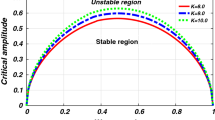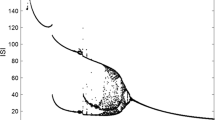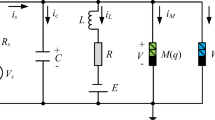Abstract
The last two decades have seen many literatures on the mathematical and computational analysis of neuronal activities resulting in many mathematical models to describe neuron. Many of those models have described the membrane potential of a neuron in terms of the leakage current and the synaptic inputs. Only recently researchers have proposed a new neuron model based on the electromagnetic induction theorem, which considers inner magnetic fluctuation and external electromagnetic radiation as a significant missing part that can participate in neural activity. While the flux coupling of the membrane is considered equivalent to a memductance function of a memristor, standard memductance model of \(\alpha + 3\beta \phi^{2}\) has been used in the literatures, but in this paper we propose a new memductance function based on discontinuous flux coupling. Various dynamical properties of the neuron model with discontinuous flux coupling are studied and interestingly the proposed model shows hyperchaotic behavior which was not identified in the literatures. Furthermore, we consider a ring network of the proposed model and investigate whether the chimera state can emerge. The chimera state relates to the state with simultaneously coherence and incoherence in oscillatory networks and has received much attention in recent years.






Similar content being viewed by others
References
Abrams DM, Strogatz SH (2004) Chimera states for coupled oscillators. Phys Rev Lett 93:174102
Belykh V, Belykh I, Colding-Jørgensen M, Mosekilde E (2000) Homoclinic bifurcations leading to the emergence of bursting oscillations in cell models. Eur Phys J E 3:205–219
Braun HA, Schäfer K, Voigt K, Peters R, Bretschneider F, Pei X et al (1997) Low-dimensional dynamics in sensory biology 1: thermally sensitive electroreceptors of the catfish. J Comput Neurosci 4:335–347
Braun HA, Schwabedal J, Dewald M, Finke C, Postnova S, Huber MT et al (2011) Noise-induced precursors of tonic-to-bursting transitions in hypothalamic neurons and in a conductance-based model. Chaos Interdiscip J Nonlinear Sci 21:047509
Coombes S, Osbaldestin AH (2000) Period-adding bifurcations and chaos in a periodically stimulated excitable neural relaxation oscillator. Phys Rev E 62:4057
Dtchetgnia Djeundam S, Yamapi R, Kofane T, Aziz-Alaoui M (2013) Deterministic and stochastic bifurcations in the Hindmarsh–Rose neuronal model. Chaos Interdiscip J Nonlinear Sci 23:033125
Dudkowski D, Maistrenko Y, Kapitaniak T (2014) Different types of chimera states: an interplay between spatial and dynamical chaos. Phys Rev E 90:032920
Dudkowski D, Maistrenko Y, Kapitaniak T (2016) Occurrence and stability of chimera states in coupled externally excited oscillators. Chaos Interdiscip J Nonlinear Sci 26:116306
González-Miranda JM (2003) Observation of a continuous interior crisis in the Hindmarsh–Rose neuron model. Chaos Interdiscip J Nonlinear Sci 13:845–852
González-Miranda J (2007) Complex bifurcation structures in the Hindmarsh–Rose neuron model. Int J Bifurc Chaos 17:3071–3083
Gu H, Yang M, Li L, Liu Z, Ren W (2003) Dynamics of autonomous stochastic resonance in neural period adding bifurcation scenarios. Phys Lett A 319:89–96
Gu H, Pan B, Chen G, Duan L (2014) Biological experimental demonstration of bifurcations from bursting to spiking predicted by theoretical models. Nonlinear Dyn 78:391–407
Hindmarsh JL, Rose R (1984) A model of neuronal bursting using three coupled first order differential equations. Proc R Soc Lond B 221:87–102
Hizanidis J, Kanas VG, Bezerianos A, Bountis T (2014) Chimera states in networks of nonlocally coupled Hindmarsh–Rose neuron models. Int J Bifurc Chaos 24:1450030
Innocenti G, Morelli A, Genesio R, Torcini A (2007) Dynamical phases of the Hindmarsh–Rose neuronal model: studies of the transition from bursting to spiking chaos. Chaos Interdiscip J Nonlinear Sci 17:043128
Izhikevich EM (2004) Which model to use for cortical spiking neurons? IEEE Trans Neural Netw 15:1063–1070
Kapitaniak T, Kuzma P, Wojewoda J, Czolczynski K, Maistrenko Y (2014) Imperfect chimera states for coupled pendula. Sci Rep 4:6379
Lu Q, Gu H, Yang Z, Shi X, Duan L, Zheng Y (2008) Dynamics of firing patterns, synchronization and resonances in neuronal electrical activities: experiments and analysis. Acta Mech Sin 24:593–628
Lv M, Ma J (2016) Multiple modes of electrical activities in a new neuron model under electromagnetic radiation. Neurocomputing 205:375–381
Lv M, Wang C, Ren G, Ma J, Song X (2016) Model of electrical activity in a neuron under magnetic flow effect. Nonlinear Dyn 85:1479–1490
Ma J, Tang J (2015) A review for dynamics of collective behaviors of network of neurons. Sci China Technol Sci 58:2038–2045
Ma J, Tang J (2017) A review for dynamics in neuron and neuronal network. Nonlinear Dyn 89:1569–1578
Ma J, Wang Y, Wang C, Xu Y, Ren G (2017) Mode selection in electrical activities of myocardial cell exposed to electromagnetic radiation. Chaos Solitons Fractals 99:219–225
Majhi S, Perc M, Ghosh D (2016) Chimera states in uncoupled neurons induced by a multilayer structure. Sci Rep 6:39033
Majhi S, Perc M, Ghosh D (2017) Chimera states in a multilayer network of coupled and uncoupled neurons. Chaos Interdiscip J Nonlinear Sci 27:073109
Mishra A, Saha S, Ghosh D, Osipov GV, Dana SK (2017) Traveling chimera pattern in a neuronal network under local gap junctional and nonlocal chemical synaptic interactions. Opera Medica Physiol 3:14–18
Moujahid A, d’Anjou A, Torrealdea F, Torrealdea F (2011) Efficient synchronization of structurally adaptive coupled Hindmarsh–Rose neurons. Chaos Solitons Fractals 44:929–933
Omelchenko I, Provata A, Hizanidis J, Schöll E, Hövel P (2015) Robustness of chimera states for coupled FitzHugh–Nagumo oscillators. Phys Rev E 91:022917
Parastesh F, Jafari S, Azarnoush H, Hatef B, Bountis A (2018) Imperfect chimeras in a ring of four-dimensional simplified Lorenz systems. Chaos Solitons Fractals 110:203–208
Schmidt A, Kasimatis T, Hizanidis J, Provata A, Hövel P (2017) Chimera patterns in two-dimensional networks of coupled neurons. Phys Rev E 95:032224
Storace M, Linaro D, de Lange E (2008) The Hindmarsh–Rose neuron model: bifurcation analysis and piecewise-linear approximations. Chaos Interdiscip J Nonlinear Sci 18:033128
Terman D (1991) Chaotic spikes arising from a model of bursting in excitable membranes. SIAM J Appl Math 51:1418–1450
Terman D (1992) The transition from bursting to continuous spiking in excitable membrane models. J Nonlinear Sci 2:135–182
Wang X-J (1993) Genesis of bursting oscillations in the Hindmarsh–Rose model and homoclinicity to a chaotic saddle. Physica D 62:263–274
Wang Y, Ma J, Xu Y, Wu F, Zhou P (2017) The electrical activity of neurons subject to electromagnetic induction and Gaussian white noise. Int J Bifurc Chaos 27:1750030
Wolf A, Swift JB, Swinney HL, Vastano JA (1985) Determining Lyapunov exponents from a time series. Physica D 16:285–317
Yang M, Liu Z, Li L, Xu Y, Liu H, Gu H et al (2009) Identifying distinct stochastic dynamics from chaos: a study on multimodal neural firing patterns. Int J Bifurc Chaos 19:453–485
Author information
Authors and Affiliations
Corresponding author
Rights and permissions
About this article
Cite this article
Parastesh, F., Rajagopal, K., Karthikeyan, A. et al. Complex dynamics of a neuron model with discontinuous magnetic induction and exposed to external radiation. Cogn Neurodyn 12, 607–614 (2018). https://doi.org/10.1007/s11571-018-9497-x
Received:
Revised:
Accepted:
Published:
Issue Date:
DOI: https://doi.org/10.1007/s11571-018-9497-x




